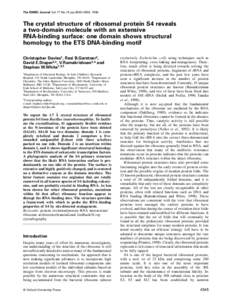 Date: 2007-05-08 05:11:10Protein biosynthesis Proteins Protein domains Protein structure Ribosomal protein LSm RNA polymerase 16S ribosomal RNA Ribosome Biology Genetics RNA | |  The EMBO Journal Vol.17 No.16 pp.4545–4558, 1998 The crystal structure of ribosomal protein S4 reveals a two-domain molecule with an extensive RNA-binding surface: one domain shows structural homology to the ETS DNA-b The EMBO Journal Vol.17 No.16 pp.4545–4558, 1998 The crystal structure of ribosomal protein S4 reveals a two-domain molecule with an extensive RNA-binding surface: one domain shows structural homology to the ETS DNA-b
Add to Reading ListSource URL: www.mrc-lmb.cam.ac.ukDownload Document from Source Website File Size: 954,41 KBShare Document on Facebook
|

